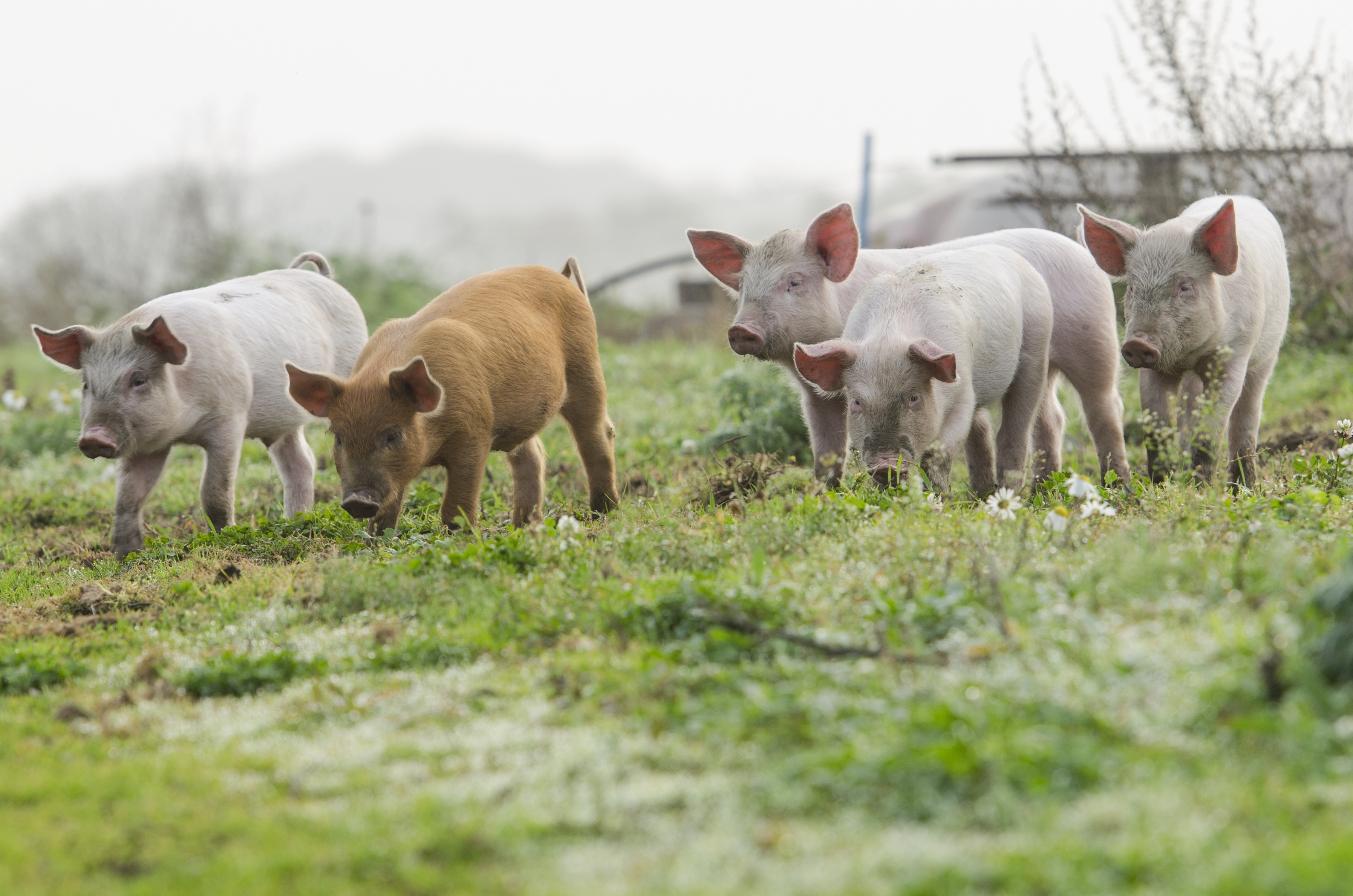Pork
Pork is the meat of domesticated porcine (pigs). Pigs are also called swine or hogs.
In Canada, the average pig goes to market between 6-8 months old and weighing between 55-95 kg. Suckling pig is used to describe very young pigs that have only been fed on its mother's milk. Those piglets are between 2-6 weeks old and the meat is very tender, gelatinous but also somewhat mushy.

Unique Qualities of Pork
Pork meat has two-toning. Different forms of myoglobin result in lighter or darker meat. Even when cooked, the colour of the meat looks like different shades.
Another unique trait in pork which is different from other meats is that pork skin is often left on.
Aging
Unlike beef, pork is not aged. The animal is much younger than beef and the meat is already much more tender than beef. Due to its high moisture content, bacteria would multiply quickly if given the time during aging. If pork were aged, it would have much lower yields because of moisture loss. Also, pork fat can go rancid because of oxidation.
Food Safety
Trichinosis is a parasitic disease caused by the eating of raw or undercooked pork that is infected with roundworm. (It is also found in wild game.) That being the case, Health Canada advises consumers to cook pork until it reaches 58 degrees C. By freezing pork, the larvae/worms are killed. Someone affected with trichinosis can present symptoms of nausea and heartburn after 1-2 days.
Salmonella is also a concern in pork. Pork is a relatively moist meat and can therefore grow rapidly.
Pork and Religious Diets
For those who practice Judaism and Islam, pork is not permissible. In Judaism, pork is not kosher and not allowed whatsoever. Pigs are an anomaly because of their cloven hoofs and that they don't chew their cud like ruminant animals (for example cows). In Islam, pork is haram (Arabic), not halal. Halal means that is permissible by Islamic law. Religious beliefs revolving food and diets must be respected and carefully managed in the hospitality industry.
Ways to Cook
Pork is the meat of choice for many cultures around the world.
Pork Fat
Pork fat is rather neutral-tasting and there are many uses for pork fat in dishes that otherwise do not have pork.
- for barding (outside of a product)
- larding (inside of a product)
- forcemeats using other meats as the main flavour/ingredient
- meatballs, burgers, sausages that otherwise do not have pork
- charcuterie
- caul fat used to cover and roast other meats
"Rattlesnakes" is an old cowboy slang word for bacon rashers. (Canadian Food Words p 242)
More About Cooking Pork
Some of our favourite videos
Alberta Pork Producers
Rocky Mountain Game Meats
About this producerFoods from this producer:
-
- Domesticated
- Fur
Beef
-
- Domesticated
- Feather
Chicken
-
- Domesticated
- Fur
Lamb
-
- Domesticated
- Fur
Pork
-
- Wild Game
- Fur
Bison
-
- Wild Game
- Fur
Venison
-
- Wild Game
- Fur
Wild Boar
-
- Wild Game
- Fur
Pronghorn
-
- Wild Game
- Fur
Rabbit
-
- Wild Game
- Feather
Duck
-
- Wild Game
- Feather
Partridge
-
- Wild Game
- Feather
Pheasant
-
- Domesticated
- Feather
Quail
Green Work Farms
About this producerFoods from this producer:
TK Ranch
About this producerFoods from this producer:
Meadow Creek Farms
About this producerFoods from this producer:
Coen Farm
About this producerFoods from this producer:
Nature's Green Acres
About this producerFoods from this producer:
Serben Farms
About this producerFoods from this producer:
Sunshine Organic Farm
About this producerLazuli Farms
About this producerFoods from this producer:
Backwoods Buffalo Ranch
About this producerFoods from this producer:
Grazed Right Grass Fed Beef
About this producerFoods from this producer:
Hoven Farms
About this producerFoods from this producer:
Blue Ridge Farms
About this producerFoods from this producer:
Schielke Farm
About this producerFoods from this producer:
Redtail Farms
About this producerFoods from this producer:
Hogs & Horns Homestead
About this producerFoods from this producer:
Sunhaven Farms
About this producerFoods from this producer:
Irvings Farm Fresh
About this producerFoods from this producer:
Broek Pork Acres
About this producerFoods from this producer:
Stonepost Farms
About this producerSunworks Farm
About this producerSpragg's Meat Shop
About this producerFoods from this producer:
-
Rocky Mountain Game Meats
Rocky Mountain Game Meats, 55 Avenue Northeast, Calgary, AB, Canada
-
Green Work Farms
49325 Range Road 262, Leduc County, AB, Canada
-
TK Ranch
TK Ranch, Inverlake Road, Calgary, AB, Canada
-
Meadow Creek Farms
Meadow Creek Farms, Waskatenau, AB, Canada
-
Coen Farm
Coen Farm, Ferintosh, AB, Canada
-
Nature's Green Acres
Nature's Green Acres, Viking, AB, Canada
-
Serben Farms
Serben Farms, Smoky Lake, AB, Canada
-
Sunshine Organic Farm
Sunshine Organic Farm, Range Road 34, Warburg, AB, Canada
-
Lazuli Farms
Lazuli Farms, Township Road 484, Camrose, AB, Canada
-
Backwoods Buffalo Ranch
Backwoods Buffalo Ranch, Woodlands County, AB, Canada
-
Grazed Right Grass Fed Beef
Grazed Right, Black Diamond, AB, Canada
-
Hoven Farms
Hoven Farms Grass Finished Organic Beef, Eckville, AB, Canada
-
Blue Ridge Farms
Blue Ridge Farms, Range Road 102, Blue Ridge, AB, Canada
-
Schielke Farm
21174 Township Road 455, New Norway, AB, Canada
-
Redtail Farms
Redtail Farms, Castor, AB, Canada
-
Hogs & Horns Homestead
Hogs and Horns Homestead, Minburn County No. 27, AB, Canada
-
Sunhaven Farms
SUNHAVEN FARMS, Township Road 520, Sherwood Park, AB, Canada
-
Irvings Farm Fresh
Irvings Farm Fresh Ltd, Township Road 484, Round Hill, AB, Canada
-
Broek Pork Acres
Broek Pork Acres, Lethbridge Country, AB, Canada
-
Stonepost Farms
Stonepost Farms, Range Road 105, Wildwood, AB, Canada
-
Sunworks Farm
Sunworks Farms, Armena, AB, Canada
-
Spragg's Meat Shop
Spragg's Meat Shop, Centre Street, Rosemary, AB, Canada
